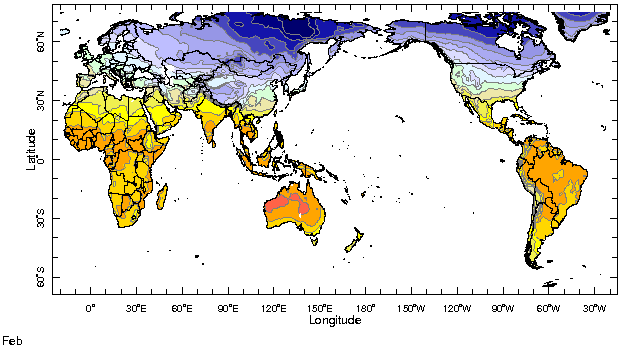|
IRI Climate Digest
March 2002
February Global Climate Summary
Climatological Background
In February, the sun is retreating from its southernmost excursion (23 South) on its approach toward the equator in mid-March (the equinox). It is end of summer in the Southern Hemisphere and the monsoon systems typically achieve their maximum intensity in Africa, Australia, Indonesia, and South America. Winter in the Northern Hemisphere generally peaks with the north-south temperature differences beginning to drive the mid-latitude jet stream northward.
Monthly Mean Temperature (1961-1990), data from the Climate Research
Unit, University of East Anglia


Monthly Mean Precipitation (1961-1990), data from the Climate Research
Unit, University of East Anglia


Temperatures
The most notable feature of global temperatures continued to be above-average conditions over much of the Northern Hemisphere midlatitudes.
Europe and Asia: Almost all of Eurasia from 35N to 65N experienced temperatures considerable above average, although eastern Siberia recorded sub-average temperatures. The pattern of temperature anomalies is quite similar to the previous month and appears to be related to the Artic Oscillation
North America: Warm temperatures continued for a fourth straight month in central North America. Cooler conditions continued from January in northeast Canada.
South America: Near- to slightly above-normal temperatures continued throughout South America.
North and West Africa: In conjunction with warm coastal SSTs, temperatures along the western Atlantic coast of North Africa remained slightly above normal while below-average temperatures were recorded in the interior Sahel.
Australia: Areas of western and southern Australia were colder than average for the fifth consecutive month.
Temperature Difference from the 1961-1990 mean, with data
from NCEP Climate Prediction Center, CAMS.


Precipitation
Broadly, precipitation in the Northern Hemisphere was generally enhanced in the higher midlatitudes, while suppressed in a belt from 25 to 40N. This pattern of precipitation, along with the sea level pressure and surface temperature anomalies, appears related to the observed positive values of the Arctic Oscillation since the beginning of January. In the southern hemisphere, there were large areas of suppressed precipitation in the Indian and Pacific oceans, but generally mixed patterns over the land masses.
North Africa and the Middle East: A broad swath of precipitation deficits was observed across North Africa, the eastern Mediterannean, and the Middle East. Regions of enhanced precipitation, however, were observed in Tunisia, Libya, and eastern portions of Afghanistan and Pakistan
Southern Africa and the Greater Horn: Rainfall deficits occurred over much of the region. Greater than average rainfall occurred in regions of Angola, Namibia, and Malawi.
South America: Above average rainfall was observed in areas of central South America and along the west coast. Rainfall along the west coast was consistent with the development of local El Nino conditions. Deficits were observed along much of the northwest of the continent. The pattern of anomalies was mixed over Brazil, but above average rainfall did occur over much of the reservoir regions.
North America: Dry conditions continued across much of the United States, with the most pronounced deficits occurring in the southwest and the southeast. Wetter than average conditions prevailed across much of Canada.
Southwest Asia: Deficits continued for most of the area, except for limited regions of eastern Afghanistan and Pakistan. Most Afghanistan received near-average precipitation; deficits were most severe in Iran and Iraq.
Australia, Indonesia, and New Zealand: Enhanced rainfall occurred over areas of Indonesia, including severe flooding in Java, as well as in the Australian interior. Suppressed rainfall was observed for the western and northeastern coasts of Australia and both New Zealand islands.
Precipitation Difference from 1961-1990 mean, with data
from NCEP Climate Prediction Center, CAMS-OPI.


Oceanic Conditions
Tropical Pacific: Subsurface warm anomalies continued to surface in the eastern tropical Pacific. Please see the latest IRI ENSO Update for a detailed summary and outlook.
SSTs remained above average in much of the Indian ocean, but were continuing to cool along the equator and in the Arabian Sea. The warm anomalies off the west coast Africa showed little change.
Mid latitudes: Mid-latitude SSTs remained much as in previous months, with large extensive regions of warm anomalies, opposed by cold anomalies in the eastern North and South Pacific and in the higher latitudes of the southern ocean.
Monthly Sea Surface Temperature Difference from the 1950-1979 mean,
with data from the Environmental Modeling Center, NCEP/NOAA.


Contents |
Special |
Impacts |
Climate |
Forecast
|

